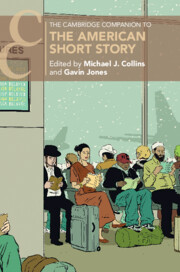Book contents
- The Cambridge Companion to the American Short Story
- The Cambridge Companion to the American Short Story
- Copyright page
- Contents
- Figures
- Tables
- Contributors
- Chronology
- Introduction
- Part I Contexts
- Part II Histories
- Part III People and Places
- Part IV Theories
- Chapter 17 Short Fiction, Language Learning, and Innocent Comedy
- Chapter 18 The Technology of the Short Story
- Chapter 19 Homelessness
- Chapter 20 The Human and the Animal
- Chapter 21 The End of the Story
- Chapter 22 The Affordances of Mere Length
- Notes
- Further Reading
- Index
- Cambridge Companions to…
- References
Chapter 21 - The End of the Story
Grammar, Gender, and Time in the Contemporary Short Story
from Part IV - Theories
Published online by Cambridge University Press: 11 May 2023
- The Cambridge Companion to the American Short Story
- The Cambridge Companion to the American Short Story
- Copyright page
- Contents
- Figures
- Tables
- Contributors
- Chronology
- Introduction
- Part I Contexts
- Part II Histories
- Part III People and Places
- Part IV Theories
- Chapter 17 Short Fiction, Language Learning, and Innocent Comedy
- Chapter 18 The Technology of the Short Story
- Chapter 19 Homelessness
- Chapter 20 The Human and the Animal
- Chapter 21 The End of the Story
- Chapter 22 The Affordances of Mere Length
- Notes
- Further Reading
- Index
- Cambridge Companions to…
- References
Summary
Since Edgar Allan Poe’s assertion that the short story must be read in a “single sitting,” short story theory has focused on the importance of endings as a hallmark of the form. This crystallized, in the 1980s and 1990s, in the rise of closure studies, a critical field that sought to taxonomize the ways stories end and its effects on the reader. This essay examines a feminist countertradition of short story writing that uses grammar as a tool to disrupt the form’s inbuilt narrative teleology. By interrogating the short story’s narrative temporality, writers such as Gertrude Stein, Lydia Davis, and Lorrie Moore use grammar to situate themselves, in distinctly gendered ways, in and against broader systems of time. Through a close examination of these writers, the essay explores how grammar offers a way of assessing not only the short story’s closures but also its various expansions and radical possibilities.
- Type
- Chapter
- Information
- The Cambridge Companion to the American Short Story , pp. 327 - 340Publisher: Cambridge University PressPrint publication year: 2023

